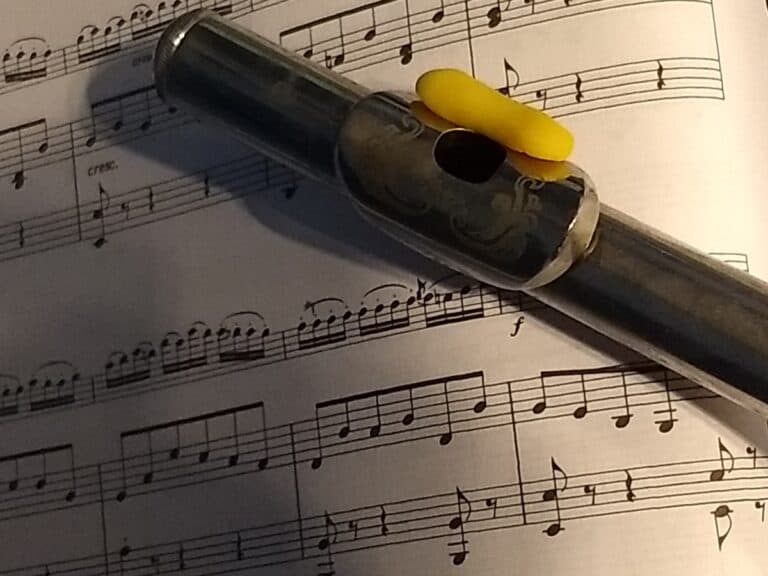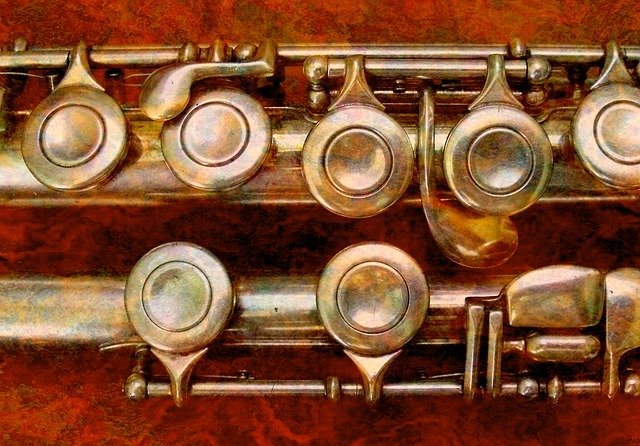How to Oil Flute Keys
Oiling your keys is a basic instrument-care process which every flutist should know. My aim is to offer you a comprehensive guide on this process, and to point out the pitfalls that you should avoid.
To properly oil your keys, place one drop of key oil (or motor oil) on every place where there is a gap between moving pieces of metal. Then press each of the keys a few times to work the oil into the mechanism, and finish by wiping off any excess oil with a clean dry microfiber cloth.
Materials
The only materials that you’ll need for this process are:
- your flute,
- a bottle of key oil (or motor oil), and
- a clean dry cloth which you will most likely throw away afterward.
The bottle of key oil should ideally have a needle attached to its spout so that you can precisely place drops of oil. You can find a bottle of key oil with the needle here.
You’ll need the cloth (preferably microfiber) to wipe off excess oil from your flute. Keep in mind that this kind of oil can irritate skin and destroy flute pads, so you don’t want to use an excess of it. The cloth will probably be ruined, so try to make sure you are using something disposable. You can find my personal recommendation here.
Basics of oiling
There are three types of areas on the flute that need oil:
- Areas in which a key attaches to a rod.
- Areas where a rod attaches to a post.
- Gaps on the rods.
The aim is to get the oil within the gaps of the machinery. The spots that I point you to in this article are areas which may have gaps which allow you to get to the internal rods. This is the reason why I recommend an oil bottle with a needle; you can use the needle to poke just underneath the outer cover of the rods to oil the inner mechanism.
Not all the areas in which a key attaches to a rod (item 1 in the above list) will have a gap through which you can access the underlying machinery, so you don’t need to oil the ones that don’t. Many do, however, and you will have to look to find where the gaps are.
Also, not every flute has gaps on the rods, so item 3 may not be relevant to every flutist. You should still look for these points nonetheless.
You don’t need much oil at all; just a drop in each area should suffice. A single bottle might last you for your entire career in music (provided that you only oil your flute when the keys feel slow and it becomes necessary).
Note that if you are having problems with one specific key, it is still better to oil every location on the specific rod that is problematic. Oil works best when it lubricates the entire rod, and oiling the machinery under one specific key may not be enough.
Some precautions in advance
Oiling your keys is a fairly basic fix, and you shouldn’t run into too many problems. Before pointing out each individual spot that you should oil, however, it is worth going over a few common pitfalls.
Don’t oil your flute too often
You should only oil your keys when you find that they’re slow. It is difficult to prescribe exactly how often you should do so, but you likely will not need to more than once every three months. This assumes regular playing for several hours every day.
Realistically, many musicians will need to oil their keys less often. One bottle (assuming you got the one I recommended above) should last you many years. If your keys start to feel rattly or resistant, though, then go ahead and oil them. The way that your keys feel is a better metric of whether you should oil them than a fixed length of time.
Less is more when it comes to key oil. If you use oil too much or use it too frequently, it can start to dissolve the glue which holds the flute together.
Only use oil on the inner machinery
Make sure that you do not deliberately oil any other part of the instrument. Oil only benefits areas between moving parts, and excessive amounts of oil could potentially lead to some getting on the pads or inside the flute. A little bit won’t hurt, but you shouldn’t go out of your way to oil an area with no moving machinery.
Try not to make a mess
On that note, keep in mind that the oil is a drying substance. It isn’t great to get on your skin (though it shouldn’t cause any permanent harm) Sometimes beginners will get oil not only on their entire flute, but also on themselves. Clean it up, and wash your hands afterward.
Don’t get it on the pads
Pads necessarily have some amount of moisture in them. The oil will dry them out and destroy them, making for an extremely expensive repair bill. Keep the oil as far from the pads as possible.
Remove dust beforehand
Finally, make sure that you remove any dust that you can spot in or on the machinery before oiling. You can do this by using a small paint brush to brush the dust away. The reason for this is that the dust can cling to oil, and wind up caught in the machinery.
Once the dust is in the machinery, there isn’t much you can do about it until the flute gets fully dismantled (which you should not attempt to do yourself; leave it to a skilled repair person if it is absolutely necessary).
This isn’t as large of a problem as it might seem. While the dust is certainly abrasive, it won’t cause serious harm to the flute unless it accumulates in large quantities. Try to avoid having dust collect in the machinery of the flute, but don’t worry about it too much if it does end up happening.
Each spot to oil
Areas on the left-hand side of the flute
The above image shows all the areas on the left-hand side of the flute which may need to be oiled. Not every flute is the same, and so some areas that I circle may not have an opening to the machinery on your flute. If they do not have an opening, then don’t bother oiling them.
Remember, you are trying to get the oil between the moving parts. While getting some oil on top of the machinery is inevitable, it does not help your instrument play better in the slightest.
Areas on the right-hand side of the flute
Again, one drop of oil in between the machinery at each location if you can find a gap there. The process isn’t too difficult and should only take a minute or so.
Some of the gaps in this image may be difficult to see because they are small. The only important thing is that you know their approximate location so that you can identify them on your own flute if they are present.
This is especially true for gaps in the rod which aren’t connected to a key or post. Typically these gaps are located on the right-hand side of the flute, and there are about 2-3 of them total. I’ve labelled them with pink circles in the above picture, as they may otherwise be difficult to find.
Working the oil into the machinery
After you’ve put a drop of oil into each spot, you’ll want to make sure that the oil goes all the way into the machinery. The oil isn’t effective if it only stays by the exposed gaps; it needs to fully lubricate the inside of the rods.
Repeatedly press all of the keys on the instrument for about a minute or so. This causes the rods to rotate and let the oil further into the machinery.
The only concern here is to make sure that you are gentle on the keys. You don’t need to press the keys too hard; just make sure that you press them enough to get the rods rotating.
Wiping the flute down afterward
The last step is to make sure that you clean off any excess oil. The best thing to use for this is a disposable dry microfiber cloth. You probably don’t want to use wipes, paper towels, or most ordinary cleaning supplies. Although it is unlikely, it is possible that being too rough with these could scratch the finish of the flute.
Again, you can find some disposable microfiber cloths here. You don’t want to use any cloth you want to keep, because the oil can be somewhat harsh. The ones that I’m linking to are disposable.
Conclusion
Oiling your keys is not a difficult process, and it is simple enough that you should be able to do it yourself without too much difficulty. It is one of the basics of woodwind instrument care, and as such it is a good skill to have in your toolset.
I hope that you are feeling more confident in your ability to oil your instrument, and wish you best of luck in flute-fixing endeavors!







